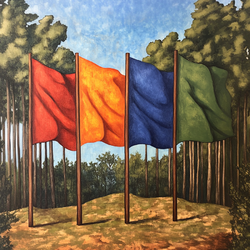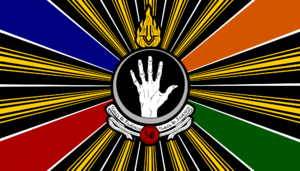Symbols of Hergom: Difference between revisions
(→Red) |
|||
| Line 36: | Line 36: | ||
==Stoldavian Blackberry plants== | ==Stoldavian Blackberry plants== | ||
[[File:BlackberryP.png|thumb|Common Stoldavian Blackberry plant]] | |||
[[Category:Symbols by country|Hergom]][[Category:Hergom]] | [[Category:Symbols by country|Hergom]][[Category:Hergom]] | ||
Revision as of 05:30, 17 August 2024
The Four Colours

Red
Red represents the blood of the Wolgos, symbolizing both their vitality and the sacrifices made over the past two hundred years. It stands as a reminder of the life force that courses through the Wolgos people, as well as the deep scars left by the conflicts that have shaped their history.
Blue
Blue signifies the celestial mandate of the Wolgos, embodying the will of Dlrocha, the divine force that brought them into existence. This colour reflects their sacred purpose and the spiritual authority bestowed upon them, reminding the Wolgos of their higher calling and the divine guidance that shapes their destiny.
Orange
Orange captures the dual nature of prosperity and the harsh realities of existence. On one hand, it symbolizes the harvest, sunlight, and the prosperity that sustains the Wolgos people. On the other hand, it serves as a reminder of the punishing pain and injury the sun can cause, reflecting the celestial power that can both nurture and test them.
Green
Green represents creation and the bounty of the natural world, a gift from Dlrocha to the Wolgos. It signifies the abundance of life, the flourishing of their environment, and the divine generosity that sustains their existence. Green is a reminder of the preciousness of creation and the responsibility the Wolgos have to rule it.
The White Hand, Golden Flame and Red Guardian

White Hand
The White Hand stands as a powerful emblem of the Wolgos people, a symbol that gained prominence after their arrival in Kupeya following the Second Wolgos Trek. This hand iconography is steeped in cultural significance, representing both the Wolgos’ resilience and their claim to their new homeland. According to tradition, the White Hand commemorates a semi-mythical event in which a young Wolgos man became the first to disembark from the evacuation ships, setting foot on the shores of Kupeya. It is said that he was the first to touch a towering monolith that stood by the beach, symbolizing the Wolgos' connection to and ownership of this new homeland.
While the story is a cornerstone of Wolgos identity, its historical accuracy is shrouded in mystery. The event is imbued with a deep sense of mysticism, and there are no definitive records identifying the first Wolgos to set foot in Kupeya, nor any clear account of who was the initial disembarker from the evacuation fleet. Despite these uncertainties, the legend persists, and the White Hand has become more than just a symbol of arrival; it is a symbol of their dominion and belief in their own superiority.
Golden Flame
The Golden Flame, often depicted alongside the Dlrochsteg symbol, is a recurring motif in Wolgos iconography. Although not officially recognized as a religious symbol of Dlroch'veldr, it has been widely embraced by the Wolgos people. The Golden Flame represents their fervent faith and is seen by many as a divine affirmation of their celestial stewardship over creation. This symbol, rich in spiritual significance, has become deeply ingrained in the cultural identity of the Wolgos, symbolizing both their religious devotion and their perceived divine mandate.
The Golden Flame is ubiquitous within Wolgos communities, appearing in various forms of art, architecture, and even daily life. However, its meaning can be more complex outside these communities, particularly in regions with a history of conflict involving the Wolgos. In some of these foreign lands, the symbol has taken on a darker connotation, being regarded as a hate symbol due to its association with past hostilities. For instance, during both Coalition Wars, it was not uncommon for prisoners of war to be branded with the Golden Flame, a practice that has left a lasting scar on the collective memory of those nations.
Red Guardian
The Red Guardian, known as H’ghes, is a revered religious symbol within Wolgos culture, embodying the essence of life, fertility, and the hope for growth. This symbol is frequently invoked in prayers and rituals, particularly as a beacon of hope for the birth of new Wolgos children and the flourishing of their communities. Over time, H’ghes has evolved to represent more than just fertility; it has come to symbolize the Wolgos’ indomitable spirit, their relentless drive to survive, and their ability to rise anew even after the devastating losses suffered in past wars.
In the face of these profound losses, where entire generations were nearly wiped out, the Red Guardian has become a powerful emblem of resurgence and renewal. For the Wolgos, H’ghes is not merely a symbol of biological fertility, but a broader representation of their cultural and spiritual rebirth. It serves as a reminder of their enduring resilience, the continuity of their lineage, and their unwavering commitment to ensuring the survival and prosperity of their people, no matter the adversities they have faced.
Flag of Hergom

Stoldavian Blackberry plants
